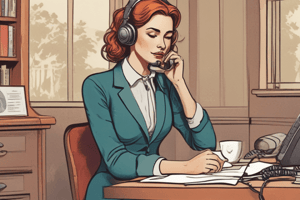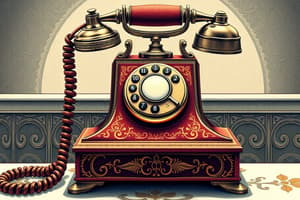Podcast
Questions and Answers
What is the MOST important reason for clearing your mind before answering a customer service call?
What is the MOST important reason for clearing your mind before answering a customer service call?
- To avoid appearing unprofessional due to distractions. (correct)
- To quickly resolve the call and move on to other tasks.
- To reduce stress and improve personal well-being.
- To ensure you remember all the company policies.
Why is the initial stage of a customer service call often referred to as a 'verbal handshake'?
Why is the initial stage of a customer service call often referred to as a 'verbal handshake'?
- Because it sets the tone and direction for the entire interaction. (correct)
- Because it involves physically greeting the customer.
- Because it is a brief and insignificant part of the call.
- Because it requires a formal agreement or contract.
Which action BEST demonstrates being 'present' with a caller during a telephone conversation?
Which action BEST demonstrates being 'present' with a caller during a telephone conversation?
- Jotting down notes while simultaneously addressing emails.
- Following a strict script to maintain consistency.
- Quickly resolving the issue to minimize call duration.
- Actively listening and focusing solely on the caller's needs. (correct)
What is the PRIMARY purpose of adhering to telephone etiquette in customer service?
What is the PRIMARY purpose of adhering to telephone etiquette in customer service?
In addition to focusing solely on the caller, what other action demonstrates effective phone etiquette at the start of a call?
In addition to focusing solely on the caller, what other action demonstrates effective phone etiquette at the start of a call?
Flashcards
Telephone Etiquette
Telephone Etiquette
Rules governing social behavior in phone interactions, particularly customer service.
First Impressions
First Impressions
The initial perception a caller has during the start of a call, crucial for setting the tone.
Inbound vs. Outbound Calls
Inbound vs. Outbound Calls
Inbound calls are received by the business; outbound calls are made from the business to customers.
Hold Technique
Hold Technique
Signup and view all the flashcards
Ending the Call
Ending the Call
Signup and view all the flashcards
Study Notes
Module 2: Telephone Etiquette
- Telephone etiquette involves the rules governing social behavior in customer service interactions.
- Proper etiquette is essential for a positive customer experience and successful business interactions.
- Failing to follow these guidelines can negatively impact service.
Module 2 Agenda
- Important components of telephone etiquette
- Types of calls and call flow (inbound and outbound)
- Steps for initiating a call
- Handling hold procedures
- Controlling conversations
- Ending calls effectively
- Tone and personality in telephone communication
Module 2 Objectives
- Develop rapport with callers.
- Create positive first impressions.
- Differentiate between inbound and outbound call flows.
- Use hold effectively.
- Maintain conversation flow.
- Conclude calls with a positive impression.
- Convey personality and professionalism through tone.
What's Etiquette?
- Etiquette is a set of rules that govern social behavior.
- In customer service, etiquette guides interactions between businesses and clients.
Important Components of Telephone Etiquette
- Preparing to start a call
- Starting a call (e.g., answering and greeting)
- Placing callers on hold (if necessary)
- Ending the call
Preparing to Start a Call
- Clear Your Mind: Focus entirely on the call; avoid distractions like emails or documents.
- Be Present with Your Caller: Focus only on the caller; put away reading materials, gum, and avoid eating/drinking.
How to Start a Call?
- First impressions are crucial; they set the tone for the entire conversation.
- A strong verbal "handshake" leads to positive communication.
- It's important to know different types of calls (inbound and outbound).
Inbound Call Flow
- Greeting
- Security check
- Identify concerns
- Provide solutions
- Gain agreements
- Extra mile
- Closing
Outbound Call Flow
- Greeting
- Introduction
- Educate/inform
- Identify concerns
- Provide solutions
- Gain agreements
- Extra mile
- Closing
How to Start a Call (Steps)
- Step 1: One Ring: With interactive voice response (IVR), allow the caller sufficient time to reach their desired extension before becoming impatient.
- Step 2: Smile: A smile (even if not visible) is perceptible to the caller.
- Step 3: Salutation and Introduction: Greet the caller with a professional salutation and introduce the company.
- Step 4: Introduce Yourself: Introduce your role to the caller.
- Step 5: Offer Help: Ask "How may I assist you?"
- Step 6: Listen and Acknowledge: Actively listen and acknowledge the caller by acknowledging concerns, criticisms, or objections.
Placing the Customer on Hold
- Step 1: Seek permission ("May I place you on hold?")
- Step 2: Explain why the hold is necessary
- Step 3: Give a time frame estimate ("I'll be right back")
- Step 4: Wait for permission
- Step 5: Keep checking back and notifying the caller on hold about progress or any delays.
- Step 6: Thank the caller for their patience upon returning.
Controlling the Conversation
- Step 1: Don't initiate unnecessary conversations.
- Step 2: Reply minimally and avoid being aggressive.
- Step 3: Redirect to the purpose of the call.
Remember
- Avoid eating, chewing gum, or making noisy sounds.
- Don't use the mute button; use the hold feature instead.
- Maintain communication during holds by keeping the caller informed or asking questions.
Ending the Call
- Step 1: Summarize actions taken to resolve their issue.
- Step 2: Indicate future service access (e.g., website or online tools).
- Step 3: Offer additional assistance ("Is there anything else?").
- Step 4: Provide a positive close ("It was wonderful speaking with you").
Call Listening
How to Give Your Voice a Personality
- Clarity: Speak clearly and distinctly, with appropriate volume.
- Expressiveness: Vary tone and pace to create a positive experience.
- Conversational Tone: Keep tone and language natural and simple; convey you are a person, not a machine.
- Alertness: Use an energetic, positive voice that reflects a keen attention to the conversation
- Pleasantness: Avoid monotone voice; vary pitch smoothly and naturally.
Activity
- Volunteers can practice telephone etiquette on tasks such as flight announcements, recorded audio, and company IVR.
Studying That Suits You
Use AI to generate personalized quizzes and flashcards to suit your learning preferences.




